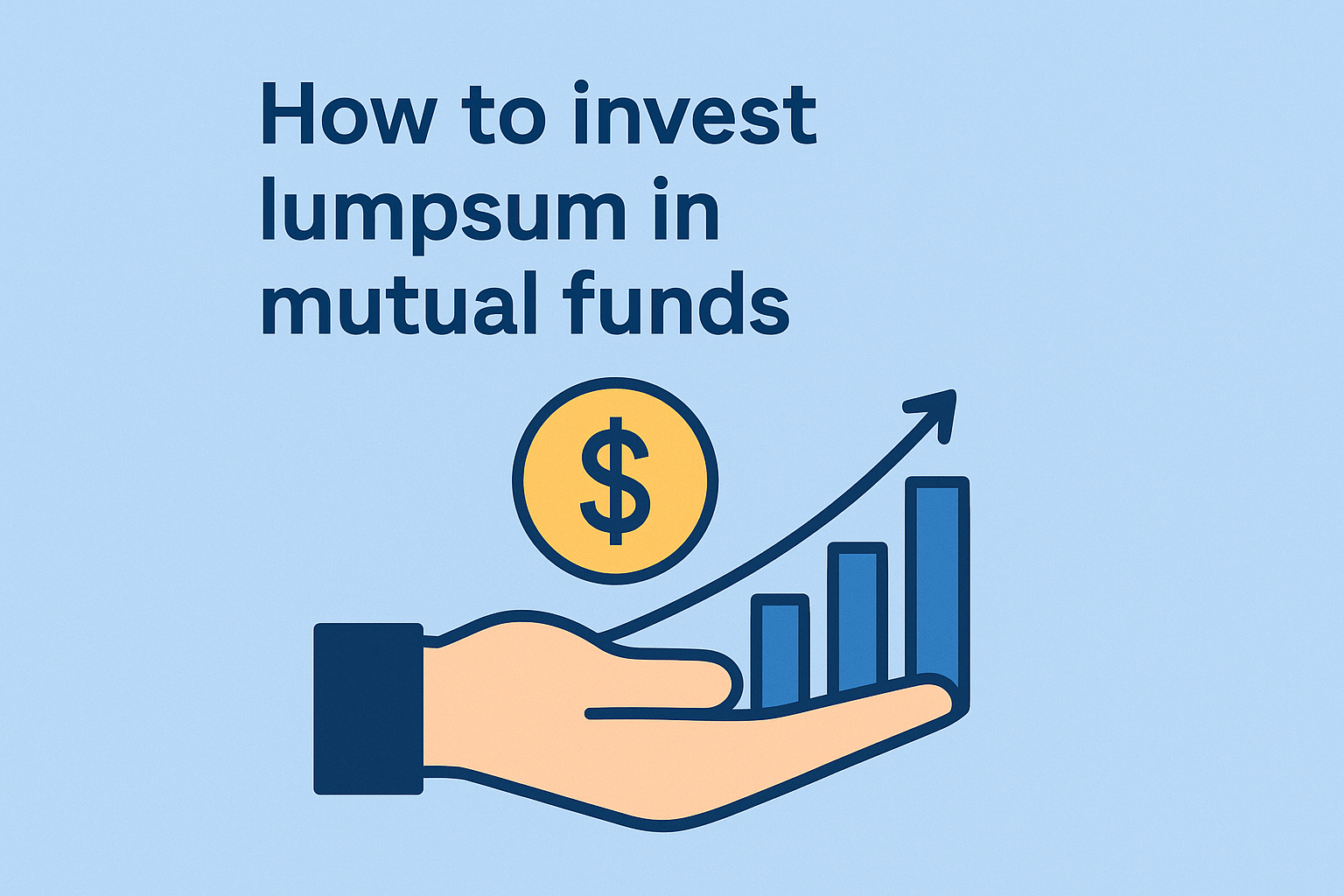How to invest lumpsum in mutual funds

Introduction:
If you are planning to invest in mutual funds, investing a lumpsum amount can be a better idea, as it can put your idle money to work, and help you create long-term wealth. Unlike a Systematic Investment Plan (SIP), where you invest small amounts at the regular intervals of time, with lumpsum investment you commit a significant amount of money at once.
This approach can be effective if you have received a huge pool of money, either through a bonus, inheritance, or surplus funds, which you want to invest, and grow through market-linked investments.
While Lumpsum investment in mutual funds is attractive, you also need to understand the timing, risk profile, and selection, as these play a crucial role in determining your returns. Therefore, in this article, we will guide you on how to invest in a lumpsum wisely and strategically to maximize your growth while managing risks.
What is Lumpsum Investment?
In India, lumpsum investment is one of the most popular ways to invest in mutual funds. In this investment, the investor invests a substantial amount of money at once instead of bifurcating it into smaller amounts at regular intervals.
While a lumpsum investment is a common way to invest in mutual funds, it does come with its own set of risks. Therefore, we can say that lump sums are good for investors who have a substantial amount of ideal money, and risk-taking capacity.
How Does Lumpsum Investment Work?
As already mentioned, lumpsum investment means that you are investing a large amount of money at the same time, instead of small regular payments. In this investment method, the full amount is invested based on the Net Asset Value (NAV) of the fund on that particular day.
As all your payment is invested at one go, you get the benefit of full market growth from day one. Here the formula to calculate lumpsum return calculator:
Lumpsum return = Investment amount × (1 + r)^n
Where:
- r = expected rate of return (in decimal)
- n = number of years
- For example, if you invest ₹1,00,000 at 10% for 5 years:
- ₹1,00,000 × (1 + 0.10)^5 = ₹1,61,051 (approx.)
Features of Lumpsum Investment in Mutual Funds:
When you are planning to make a lumpsum investment in mutual funds, there are several important features that need consideration. Some of them include:
One-Time Payment: With lumpsum payment, you make your entire amount to get invested at once. This is simple, and stress-free, as there is no need to track SIP dates, or worry about missed monthly payments.
Full Market Growth: As your full amount is invested on the first day, your money starts working from that moment. Therefore, you can take full advantage of any market rise right from the start.
Your Money Grow Faster: When your entire idle money is invested in the market for a longer period of time, it brings more returns. Additionally, compounding helps your gains grow over time, as you not only earn on your capital but also on the profits it makes.
Best Suitable for Long-Term Plans: Lumpsum investment is best suitable for the people who are investing for certain future goals, like a child’s marriage, buying a home, etc. And, your money is invested in the market for a longer time, which gives it enough time to grow through compounding, and market movements.
Market Timing Matters: When you are planning to invest a big amount in the market, timing is important. For example, if you invest during a high market phase, early losses may impact your growth. Therefore, it is best to enter the market when it is more stable or slightly low.
Who Should Invest in Lumpsum Investment?
Understanding lumpsum investments and who it is for is very important:
- Incentive earners
- Risk Takers
- Long-Term Thinkers
Things to Consider Before Investing in Lumpsum Investment
Before making a lumpsum investment in mutual funds, it is essential to evaluate certain factors that can significantly impact your returns.
Minimum Investment: It is important to understand the minimum amount that you can invest. Most funds require at least Rs.5,000 to start, but after that, you can usually add more in smaller amounts (around Rs.1,000).
Holding Period: It is a better idea to hold your investment for at least 3 years, especially if it is an equity fund. Short-term goals are better suited for debt or liquid funds, as they are less risky.
Market Ups & Downs: When you put a lot of money in at once, you need to understand that it could be affected more by the fluctuations of the market. However, these are chances that you buy more units at a lower price during a market low, and later they bring higher profits, when the market goes up.
Assistance from a Financial Expert: As a lot of money is at stake, it is a better idea to consult a financial planner, as they could guide you about the market, mutual funds to invest in, and your chances of good returns increases multifold.
Benefits of Lumpsum Investment in Mutual Funds:
- High Growth Potential
- Ideal for Long-Term Investment Goals
- Convenient and Hassle-Free
Strategies to Use While Investing a Lump Sum in Mutual Funds
Investing a lump sum in mutual funds requires the right strategy. Instead of putting all your money in at once, investors can explore options like diversification, systematic transfer plans (STPs), or aligning investments with market conditions. Here are some of the smart strategies that can ensure disciplined and goal-oriented wealth creation:
Invest for a long tenure: If you are ready to invest for a long period of time, say at least 10 years or more, then lumpsum is the right option for you. Suppose you put a large amount of money in equity funds. With the volatile market, they are bound to fluctuate. If the investment is held for a longer tenure, the probability of losses gets reduced and the chances of earning higher returns increases. So, the longer you stay invested, the better it is for you.
Be mindful of the market timing: Looking at the market’s timing is another strategy to consider when planning for a long-term investment. It is advised that you invest when the market is low, but is showing signs of growth in the coming days. However, the reverse is also true. If you invest a large amount when the markets have peaked, you might end up with a loss.
Choose debt funds: Equity funds offer a higher return potential. However, they can be volatile due to their dependence on the performance of the stock market. By investing in debt funds, you can reduce your overall risk.
Conclusion
Lump sum investing in mutual funds can be an effective way to put idle money to work, provided it is done with careful planning and the right approach. By considering market conditions, personal financial goals, and risk tolerance, investors can make informed decisions that maximise returns while managing risks. Using strategies like diversification or systematic transfer plans further helps in reducing market timing risks. Ultimately, whether you are a first-time investor or an experienced one, aligning your lump sum investments with long-term objectives ensures steady growth and financial security.

Let’s grow your wealth, together
We’ve Spent 10+ Years Helping Clients
Like You Find Financial Confidence
Insights that empower your investments
Explore expert-written blogs on mutual funds, market trends,
and smart investment strategies
Let's build a wealthy Tomorrow
25+ years of experience helping investors find financial confidence



